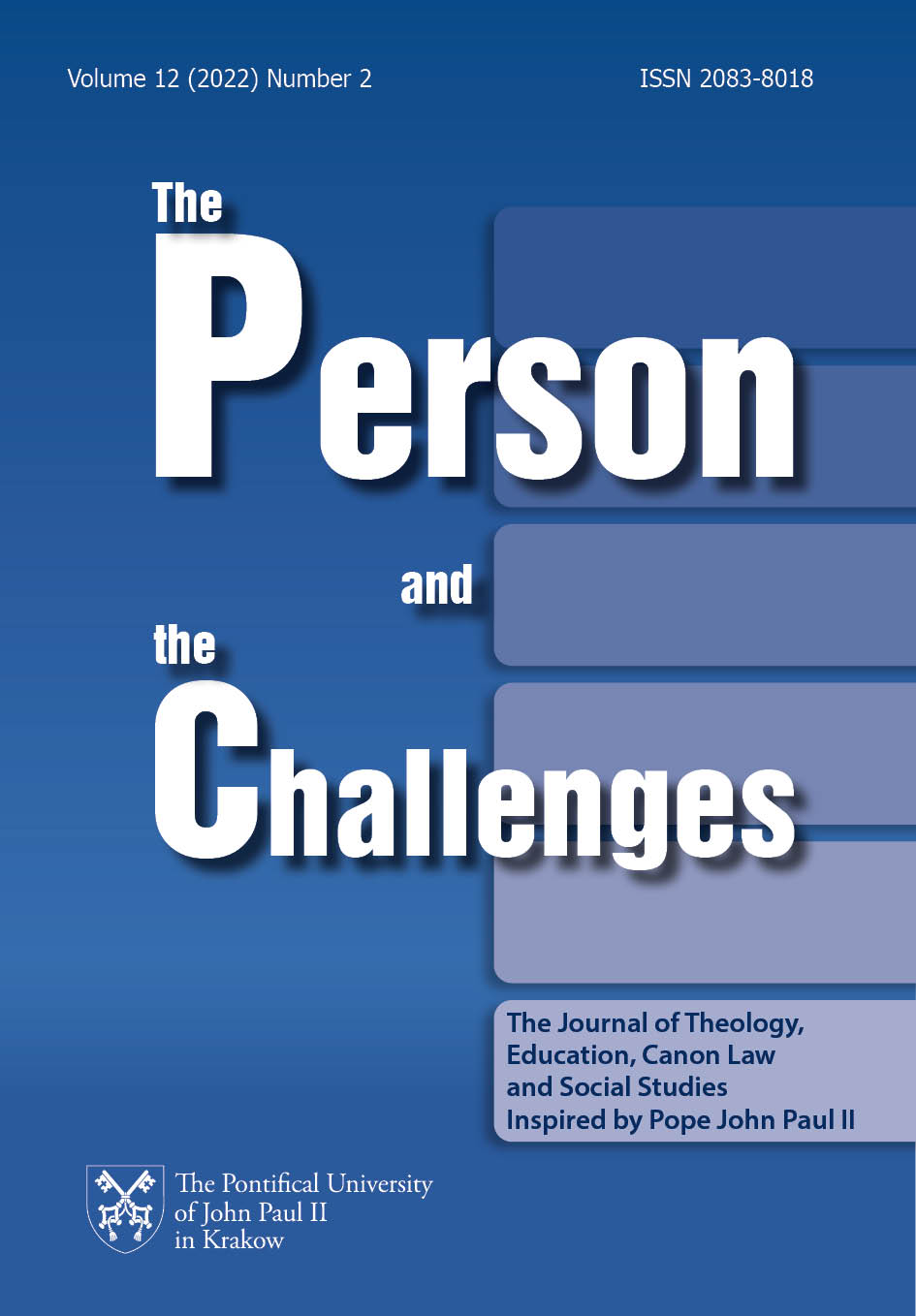Personalistic View of John Paul II on the Humanizing Function of Art in the Context of Dialogue between the Church and Artists
DOI:
https://doi.org/10.15633/pch.12204Słowa kluczowe:
dialogue, humanis, person, depersonalization, dehumanization, philosophy of artAbstrakt
This article presents the way John Paul II, the head of the Vatican at the beginning of the third millennium, theologically and philosophically substantiates and establishes the principles of a new humanism through the dialogue between the Church and art as the most personalized sphere of human activity. The conceptual essence of the key idea of the humanizing function of art, in the personalistic philosophy of art of John Paul II is revealed from the methodological standpoint of religious studies. It determines the particular nature and tasks of the renewed dialogue between the Church and artists, aimed to overcome the processes of depersonalization and dehumanization of culture, caused by atheistic humanism and growing increasingly during the 20th century. The author ponders on The Letter of Pope John Paul II to Artists and Towards a Pastoral Approach to Culture, two papal documents. Their appearance on the eve of the 2000th anniversary of Christianity became symbolic. These documents draw attention because, firstly, although the idea of a dialogue between the Church and artists as a way of embodying spiritual values of a new humanism in the theological and philosophical discourse of John Paul II had been formed over several decades, it found its conceptual solution precisely in these two papal documents. Secondly, it is in these two documents that the essence of the cultural policy of the 264th Pope is consistently set forth, meant to overcome the consequences of atheistic humanism and create a new humanism, and thus to overcome the civilizational anthropological crisis and develop a new ideological paradigm of the third millennium.
Bibliografia
Bartnik C.S., Personalizm teologiczny według kardynała Karola Wojtyły, “Zeszyty Naukowe Katolickiego Uniwersytetu Lubelskiego” 22 (1979), no. 1–3, pp. 51–60.
Basiński Prz., W służbie piękna. Karol Wojtyła o sztuce i artystach, “Przewodnik Katolicki” 7 (2014), https://www.przewodnik-katolicki.pl/Archiwum/2014/Przewodnik-Katolicki-7-2014/Wiara-i-Kosciol/W-sluzbie-piekna-Karol-Wojtyla-o-sztuce-i-artystach (23.02.2021).
Berdyaev N., Crisis of Art, Moscow 1990, Interprint.
Berdyaev N., Spirit and Reality, Kharkiv 2003, Folio.
Bijak P., Jan Paweł II jako Conservator Patrimonium Ecclesiae, “Studia Gdańskie” 30 (2012), pp. 187–202, http://cejsh.icm.edu.pl/cejsh/element/bwmeta1.element.desklight-7f7a0dba-e54b-4472-a32b-5596bd8767e7 (28.02.2021).
Fromm E., Die Seele des Menschen: Ihre Fähigkeit zum Guten und zum Bösen, Frankfurt/M.–Berlin–Wien 1981, Ullstein, http://www.irwish.de/PDF/Psychologie/Fromm/Fromm-Die_Seele_des_Menschen.pdf (19.04.2021).
Gengalo H. (ed.), Documents of the Second Vatican Council: Constitutions, Decrees, Declarations, Lviv 1996, Monastery of Monks of the Studio Charter Svichado Publishing Department.
Gorban R., Development Options for Personalistic Thought in the Countries of the Euro-Atlantic Region. Polish version: Czeslaw Stanislaw Bartnik, Kyiv 2019, Bilyi Tyhr.
Gorban R., Eschatological Prospects of History Interpreted by Nikolai Berdyaev, Ivano-Frankivsk 2014, Nova Zoria.
Jan Paweł II, Dar i Tajemnica, Kraków 2005, Wydawnictwo Św. Stanisława BM Archidiecezji Krakowskiej, https://www.rodaknet.com/rp_sw_papiez_jpII_dar_i_tajemnica. pdf (07.03.2021).
John Paul ІІ, Apostles of the Slavs, in: Encyclicals of the Ecumenical Bishop John Paul II, Toronto–Rome 1989a, Publishing House ОО. Vasyliian, pp. 170–198.
John Paul ІІ, Cross the Threshold of Hope: John Paul II Answers the Questions of Vittorio Messori, Kyiv–Lviv 1995, Kairos–Svichado.
John Paul ІІ, From one’s Own Work, in: Encyclicals of the Ecumenical Bishop John Paul II, Toronto–Rome 1989b, Publishing House ОО. Vasyliian, pp. 112–169.
John Paul ІІ, Letter of Pope John Paul II to Artists, in: H. Dydyk-Meush (ed.), Letter of Pope John Paul II, Lviv 2001, Litopys, pp. 185–215.
John Paul ІІ, Memory and Identity: Conversations at the Turn of the Millennium, Lviv 2005, Litopys.
John Paul ІІ, The Redeemer of Man, in: Encyclicals of the Ecumenical Bishop John Paul II, Toronto–Rome 1989c, Publishing House ОО. Vasyliian, pp. 7–64.
Krymsky S., Appeals to Spirituality of the 21st Century, Kyiv 2003, КМ Academy.
Lasota P., Medytacyjne przedstawienia Boga w twórczości J. Kirka Richardsa, “Archiwa, biblioteki i muzea kościelne” 109 (2018), pp. 285–297, https://doi.org/10.31743/abmk.2018.109.13 (27.02.2021).
Mandryka O. (ed.), Towards a Pastoral Approach to Culture, Lviv 2010, Svichado.
Maritain J., Knowledge and Wisdom, Мoscow 1999, trans. L. Stepachev, Nauchnyi Mir.
Mounier E., Manifeste au service du personnalisme, Paris 2003, http://dx.doi.org/doi:10.1522/cla.moe.man (17.03.2021).
Ricoeur P., History and Truth, Kyiv 2001, trans. V. Shovkun, КМ Academy – Pulsary.
Sedlmayr H., Kunst und Wahrheit: Zur Theorie und Methode der Kunstgeschichte, Mittenwald 1978, Mäander.
Tytko M.M., Artysta w koncepcji Jana Pawła II w ‘Liście do artystów’, “Religious and Sacred Poetry: An International Quarterly of Religion, Culture and Education” 1/2 (2013), pp. 117–142.
Wojtyla K., Participation or Alienation?, in: D. Fedoryka (ed.), The Experience of the Human Person: Essays on Philosophical Anthropology, Lviv 2000, Svichado, pp. 245–258.
Yermolenko A., Academic Philosophy as a ‘New Enlightenment’ for Dialogue-based Civilization, “Journal of the National Academy of Sciences of Ukraine” 11 (2019), pp. 3–12, https://doi.org/10.15407/visn2019.11.03 (20.02.2021).
Zarębianka Z., Spotkanie w Słowie. O twórczości literackiej Karola Wojtyły, Kraków 2018, Wydawnictwo Pasaże.
Pobrania
Opublikowane
Numer
Dział
Licencja
Prawa autorskie (c) 2022 Richard Gorban

Utwór dostępny jest na licencji Creative Commons Uznanie autorstwa 4.0 Międzynarodowe.
Autorzy publikujący w czasopiśmie udzielają jego wydawcy zgody o następującej treści:
- Autor zachowuje autorskie prawa majątkowe do utworu, a jednocześnie udziela wydawcy czasopisma zgody na jego pierwszą publikację w wersji drukowanej i wersji online na licencji Creative Commons Uznanie autorstwa 4.0 Międzynarodowe oraz zgody na wykonywanie opracowań, w tym przekładów.
- Autor ma możliwość udzielania zgody niewyłącznej na opublikowanie utworu w wersji, która ukazała się w czasopiśmie (np. zamieszczenia go w repozytorium instytucjonalnym lub opublikowania w książce), wraz z informacją o jego pierwszej publikacji w czasopiśmie.
- Autor może umieścić swój utwór online (np. w repozytorium instytucjonalnym lub na swojej stronie internetowej) jeszcze przed zgłoszeniem utworu do czasopisma.

